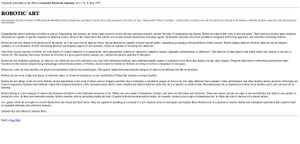1996 - Robotic Art: A Manifesto - Eduardo Kac y Marcel.lí Antúnez Roca
Text
After meeting in Helsinki in October of 1996 during the MuuMedia Festival, Eduardo Kac and Marcel.li Antunez Roca, both participants in the robotic art show “Metamachines: Where is the Body?”, at Otso Gallery, in Tapiola, and in the Art and Robotics Seminar, at the Ateneum, in Helsinki, decided to share their notes and drafted this joint statement:
Expanding the narrow definition of robots in science, engineering, and industry, art robots make room for social criticism, personal concerns, and the free play of imagination and fantasy. Robots are objects that work in time and space. Their open and diverse spatio- temporal structures are capable of specific responses to differing stimuli. Some of the visual forms that robotic art can take include autonomous real-space agents, biomorphic automata, electronic prosthetics integrated with living organisms, and telerobots (including WebBots).
Robots are not only objects to be perceived by the public-as is the case with all other art forms-but are themselves capable of perceiving the public, responding according to the possibilities of their sensors. Robots display behavior. Robotic behavior can be mimetic, synthetic, or a combination of both. Simulating physical and temporal aspects of our existence, robots are capable of inventing new behaviors.
One of the crucial concerns of robotic art is the nature of a robot’s behavior: Is it autonomous, semi-autonomous, responsive, interactive, adaptive, organic, adaptable, telepresential, or otherwise? The behavior of other agents with which robots may interact is also key to robotic art. The interplay that occurs between all involved in a given piece (robots, humans, etc.) defines the specific qualities of that piece.
Robots are not sculptures, paintings, or video art. Art robots are not to be confused in any way with mechanical-looking, static anthropomorphic statues or sculptures (even those that display moving video images). Programs that retrieve information and perform other functions on the Internet, despite being misleadingly called Internet robots, or Netbots, are not related to robotic art. Robotic art always involves a component of real space.
Robots are a new art form and they are prone to be hybridized with diverse technologies. This quality makes them transcend the category of object to be diffused into the environment.
Robotic art can occur in physical places, in telematic space, in virtual environments, or any combination of these that includes an actual location. Robots are new things in the art world. Robotic art has antecedents in the work of artists such as Tinguely and Paik, but it constitutes a completely unique art form in its own right, different from sculpture, video, performance, and other familiar artistic practices. Prototypes are found in sequential machines that endlessly repeat their temporal structures. Only microprocessors allow a more complex and distinct behavior each time, be it in specific or random form. Microprocessors are as important in robotic art as brushes, paint, and canvases are in painting.
Robots belong to a new category of objects and situations disruptive to the traditional taxonomy of art. Where one once spoke of boundaries, borders, and limits we find today new territories. These new artistic terrains are open to new possibilities and relate to one another in productive ways. In these new heterodox terrains, hybrid creatures with no preceding models are born. Coupled with telecommunications media, for example, robotics gives origin to telepresence art, in which the robot is the host of a remote subject.
As a genre, robots do not aspire to convert themselves into closed and fixed forms. They are capable of perishing as a concept if a new situation arises to encompass and surpass them. Robots exist at a juncture of creative debate and conceptual exploration that manifest themselves in expanded telematic and cybernetic domains.
File
Links
URL: http://www.leoalmanac.org/wp-content/uploads/2012/07/LEA-v5-n5.pdf
Wayback Machine: http://web.archive.org/web/20170102211225/http://www.leoalmanac.org/wp-content/uploads/2012/07/LEA-v5-n5.pdf
